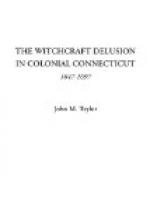It is, however, with only one of King Hammurabi’s wise laws that this inquiry has to do, and it is this:
“If a man has placed an enchantment upon a man, and has not justified himself, he upon whom the enchantment is placed to the Holy River (Euphrates) shall go; into the Holy River he shall plunge. If the Holy River holds (drowns) him he who enchanted him shall take his house. If on the contrary, the man is safe and thus is innocent, the wizard loses his life, and his house.”
Or, as another translation has it:
“If a man ban a man and cast a spell on him—if he cannot justify it he who has banned shall be killed.”
“If a man has cast a spell on a man and has not justified it, he on whom the spell has been thrown shall go to the River God, and plunge into the river. If the River God takes him he who has banned him shall be saved. If the River God show him to be innocent, and he be saved, he who banned him shall be killed, and he who plunged into the river shall take the house of him who banned him.”
There can be no more convincing evidence of the presence and power of the great witchcraft superstition among the primitive races than this earliest law; and it is to be especially noted that it prescribes one of the very tests of guilt—the proof by water—which was used in another form centuries later, on the continent, in England and New England, at Wurzburg and Bonn, at Rouen, in Suffolk, Essex and Devon, and at Salem and Hartford and Fairfield, when “the Devil starteth himself up in the pulpit, like a meikle black man, and calling the row (roll) everyone answered, Here!”
CHAPTER II
“To deny the possibility, nay actual evidence of witchcraft and sorcery, is at once to flatly contradict the revealed word of God in various passages both of the Old and New Testaments.” Blackstone’s Commentaries (Vol. 4, ch. 4, p. 60).
“It was simply the natural result of Puritanical teaching acting on the mind, predisposing men to see Satanic influence in life, and consequently eliciting the phenomena of witchcraft.” LECKY’s Rationalism in Europe (Vol. I, p. 123).
Witchcraft’s reign in many lands and among many peoples is also attested in its remarkable nomenclature. Consider its range in ancient, medieval and modern thought as shown in some of its definitions: Magic, sorcery, soothsaying, necromancy, astrology, wizardry, mysticism, occultism, and conjuring, of the early and middle ages; compacts with Satan, consorting with evil spirits, and familiarity with the Devil, of later times; all at last ripening into an epidemic demonopathy with its countless victims of fanaticism and error, malevolence and terror, of persecution and ruthless sacrifices.




